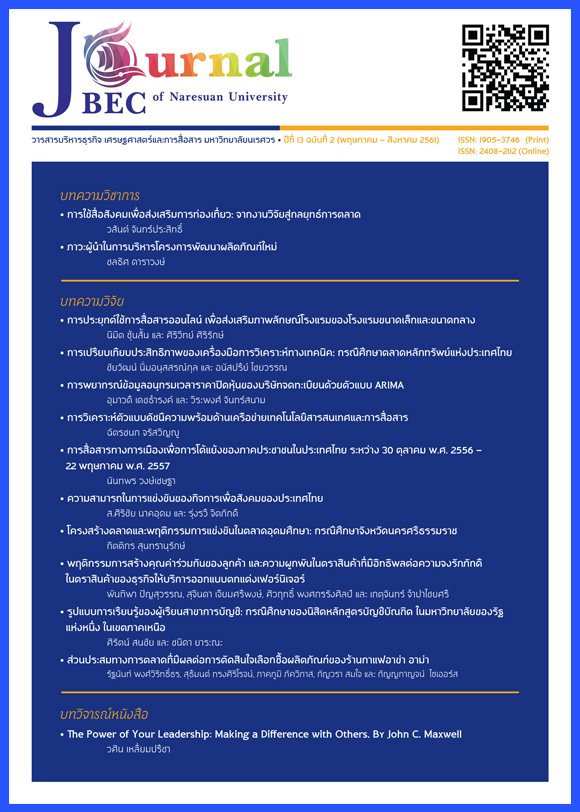การวิเคราะห์ตัวแบบดัชนีความพร้อมด้านเครือข่ายเทคโนโลยีสารสนเทศและการสื่อสาร [The Analysis of Networked Readiness Index Model]
Main Article Content
บทคัดย่อ
บทความนี้มีวัตถุประสงค์ เพื่อวิเคราะห์ตัวแบบดัชนีความพร้อมด้านเครือข่ายเทคโนโลยีสารสนเทศและการสื่อสาร โดยใช้ข้อมูลการจัดอันดับ ความพร้อมด้านเครือข่ายเทคโนโลยีสารสนเทศ ระหว่างปี ค.ศ. 2012 - 2015 ซึ่งครอบคุลม 151 ประเทศทั่วโลก อันประกอบด้วยตัวแปรแฝงจำนวน 4 ตัวแปร ได้แก่ สภาพแวดล้อม (การเมืองและธุรกิจ) ความพร้อม (โครงสร้างพื้นฐาน การเข้าถึงเทคโนโลยี และทักษะ) การใช้งาน (ระดับบุคคล ระดับธุรกิจ และระดับรัฐบาล) และผลกระทบ (เศรษฐกิจและสังคม) รวมตัวแปรสังเกตทั้งสิ้น 53 ตัวแปร ด้วยการใช้เทคนิคการวิเคราะห์ตัวแบบสมการเชิงโครงสร้างวิธีกำลังสองน้อยที่สุดบางส่วน ผลการวิเคราะห์ตัวแบบการวัด พบว่า มีตัวแปรสังเกตเพียงร้อยละ 47.17 เท่านั้นที่มีความเหมาะสมในการวัด ในขณะที่ตัวแปรแฝงทุกตัวขาดความเที่ยงตรงในการวัด อันเนื่องมาจากตัวแปรสังเกตถูกจัดกลุ่มไม่เหมาะสม นอกจากนั้น การวิเคราะห์ตัวแบบโครงสร้าง พบว่า ความพร้อม ไม่ได้มีอิทธิพลทางตรงต่อ ผลกระทบ ทั้งนี้ สภาพแวดล้อม มีอิทธิพลทั้งทางตรงและทางอ้อมผ่านการใช้งานต่อผลกระทบ รวมทั้งการใช้งานมีอิทธิพลทางตรงต่อผลกระทบ ท้ายที่สุดผลลัพธ์ได้แสดงให้เห็นถึงโอกาสในการพัฒนาตัวแบบที่มีความเหมาะสมยิ่งขึ้น โดยใช้มุมมองบนพื้นฐานทรัพยากร
Article Details
เอกสารอ้างอิง
2. Alshomrani, S. (2012). A comparative study on United Nations e-government indicators between Saudi Arabia and USA. Journal of Emerging Trends in Computing and Information Sciences, 3(3), 411-420.
3. Barney, J. B. (1986). Strategic factor markets: Expectations, luck and business strategy. Management Science, 32(10), 1231-1241.
4. Barney, J. B. (1991). Firm resources and sustained competitive advantage. Journal of Management, 17(1), 99-120.
5. Barney, J., Wright, M. and Ketchen-Jr, D. J. (2001). The resource-based view of the firm: Ten years after 1991. Journal of Management, 27(6), 625-641.
6. Bharadwaj, A. S. (2000). A resource-based perspective on information technology capability and firm performance: An empirical investigation. MIS Quarterly, 24(1), 169-196.
7. Breznik, L. (2012). Can information technology be a source of competitive advantage?. Economic and Business Review for Central and South-Eastern Europe, 14(3), 251-269.
8. Collis, D. J. (1991). A resource based analysis of global competition: The case of the bearings industry. Strategic Management Journal, 12(S1), 49-68.
9. Dutta, S. and Osorio, B. (2012). The global information technology report 2012: Living in a hyperconnected world. Geneva: World Economic Forum.
10. Dutta, S., Geiger, T. and Lanvin, B. (2015). The global information technology report 2015: ICTs for inclusive growth. Geneva: World Economic Forum.
11. Gupta, G., Tan, K. T. L., Ee, Y. S. and Phang, C. S. C. (2018). Resource-based view of information systems: Sustainable and transient competitive advantage perspectives. Australasian Journal of Information Systems, 22(1), 1-10.
12. Hair, J. F., Hult, G. T. M., Ringle, C. M. and Sarstedt, M. (2013). A primer on partial least squares structural equation modeling (PLS-SEM). London: SAGE Publications.
13. Henderson, R. and Cockburn, I. (1994). Measuring competence? Exploring firm effects in pharmaceutical research. Strategic Management Journal, 15(S1), 63-84.
14. Henseler, J., Ringle, C. M. and Sarstedt, M. (2015). A new criterion for assessing discriminant validity in variance-based structural equation modeling. Journal of the Academy of Marketing Science, 43(1), 115-135.
15. Jarvenpaa, S. L. and Leidner, D. E. (1998). An information company in Mexico: Extending the resource-based view of the firm to a developing country context. Information Systems Research, 9(4), 342-361.
16. Liang, T. P., You, J. J. and Liu, C. C. (2010). A resource-based perspective on information technology and firm performance: A meta-analysis. Industrial Management and Data Systems, 110(8), 1138-1158.
17. Liviu, B. (2015). Information technology and the company performance in the sector of services. Annals-Economy Series, 9(1), 127-133.
18. Miller, D. and Shamsie, J. (1996). The resource-based view of the firm in two environments: The Hollywood film studios from 1936 to 1965. Academy of Management Journal, 39(3), 519-543.
19. Osorio, B., Dutta, S. and Lanvin, B. (2013). The global information technology report 2013: Growth and jobs in a hyperconnected world. Geneva: World Economic Forum.
20. Osorio, B., Dutta, S. and Lanvin, B. (2014). The global information technology report 2014: Rewards and risks of big data. Geneva: World Economic Forum.
21. Peng, M. W., Wang, D. Y. and Jiang, Y. (2008). An institution-based view of international business strategy: A focus on emerging economies. Journal of International Business Studies, 39(5), 920-936.
22. Saa-Perez, P. D. and Garcia-Falcon, J. M. (2002). A resource-based view of human resource management and organizational capabilities development. International Journal of Human Resource Management, 13(1), 123-140.
23. Schroeder, R. G., Bates, K. A. and Junttila, M. A. (2002). A resource based view of manufacturing strategy and the relationship to manufacturing performance. Strategic Management Journal, 23(2), 105-117.
24. Schwab, K. (2016). The global competitiveness report 2016-2017. Geneva: World Economic Forum.
25. Silverman, B. S. (1999). Technological resources and the direction of corporate diversification: Toward an integration of the resource-based view and transaction cost economics. Management Science, 45(8), 1109-1124.
26. Subriadi, A. P., Hadiwidjojo, D., Rahayu, M. and Sarno, R. (2013). Information technology productivity paradox: A resource-based view and Iinformation technology strategic alignment perspective for measuring information technology contribution on performance. Journal of Theoretical and Applied Information Technology, 54(3), 541-552.
27. Ueasangkomsate, P. (2016). Barriers to e-commerce adoption in Thai Small and Medium Enterprises. Journal of Business, Economics and Communications, 11(2), 33-45.
28. United Nations. (2017a). United Nations e-government survey 2016. S.L.: United Nations.
29. United Nations. (2017b). Measuring the information society report 2016. S.L.: United Nations.
30. Wernerfelt, B. (1984). A resource based view of the firm. Strategic Management Journal, 5(2), 171-180.


